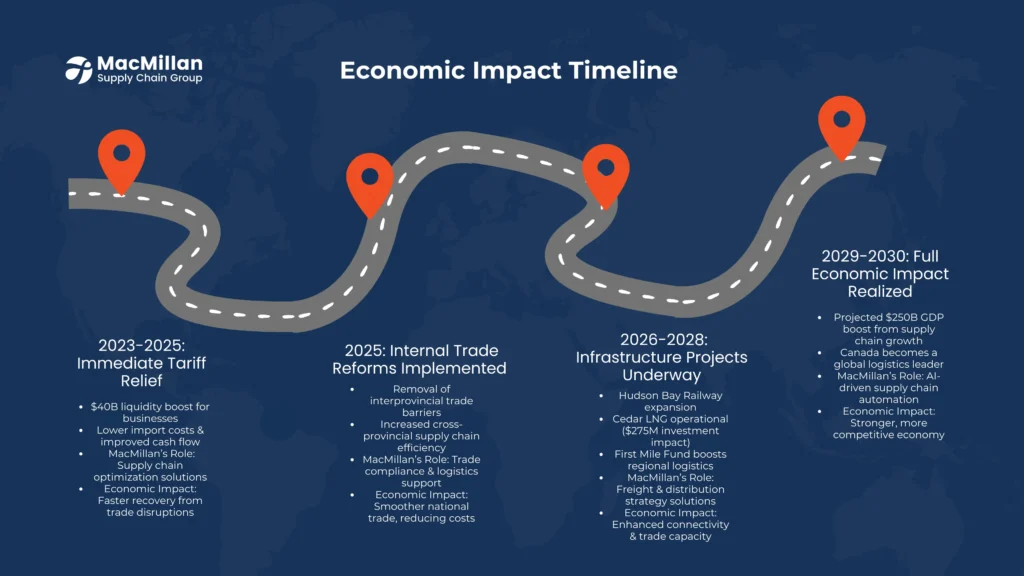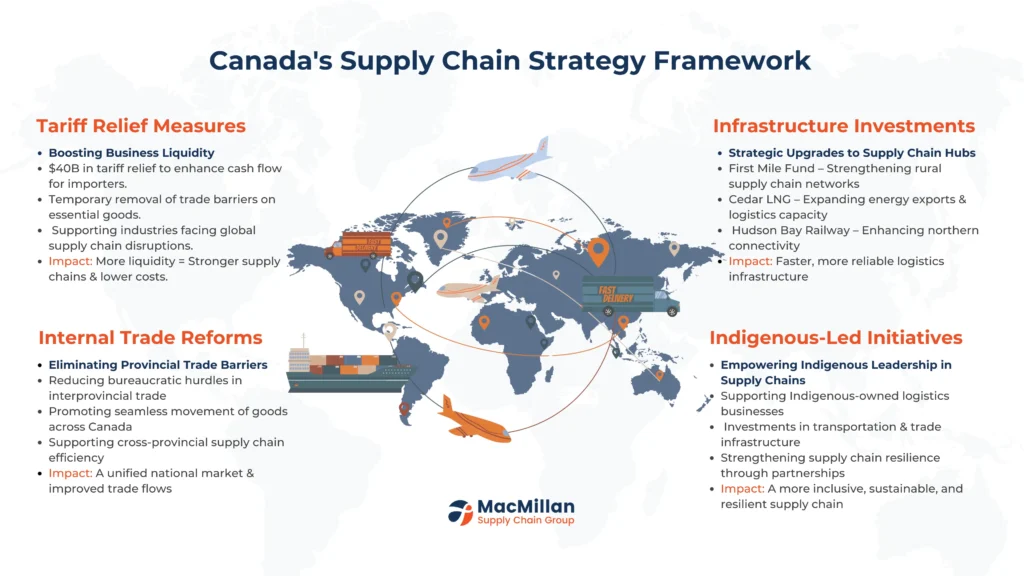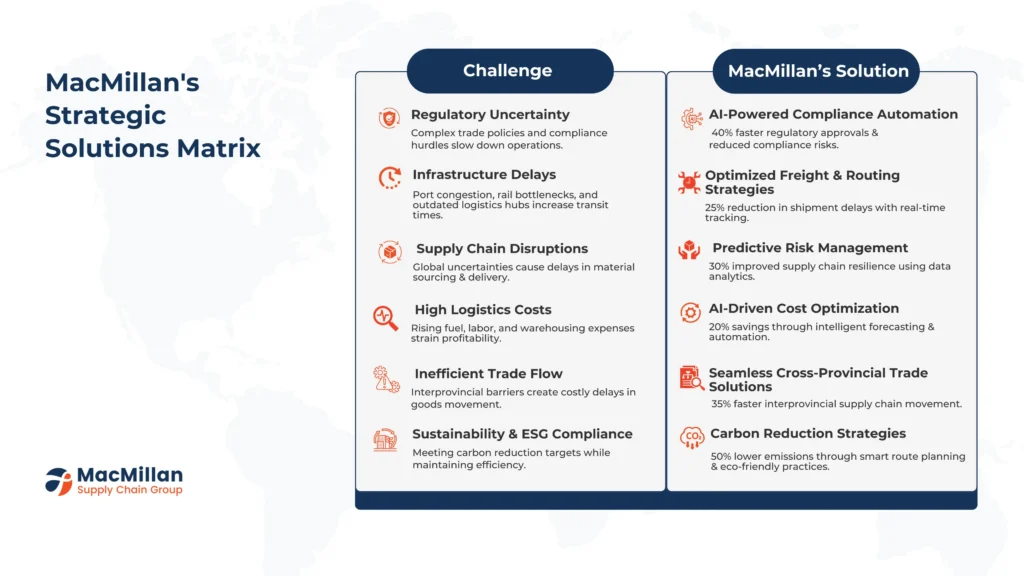A Quick Summary and Overview
PM Mark Carney’s administration has launched a comprehensive overhaul of Canada’s supply chain strategy in response to international trade pressures and domestic economic challenges. The strategy includes significant infrastructure investments, internal trade reforms, and international partnership diversification. Stronger economic resilience and less reliance on conventional trade links are the goals of important programs like the First Mile Fund, Cedar LNG Project, and EU defence partnerships. These ambitious measures aim to position Canadian companies for long-term growth and competitiveness while strengthening the country’s economy and making it more resilient to disruptions in international commerce.
Reshaping Canada’s Economic Future Through Supply Chain Innovation
Canada is reaching a turning point in its economic history. The government of Prime Minister Mark Carney has proposed a bold plan to change the way commodities move both inside and outside of Canada in response to growing supply chain disruptions and conflicts in international commerce. The comprehensive approach to supply chain strategy in Canada aims to rethink the nation’s economic foundation rather than merely address current issues.
Carney’s strategies focus on all supply chain links, from the prairies to the ports. Resource-rich areas are becoming more accessible to international markets due to to new infrastructure investments. The Canadian economy has been fragmented for a long time, but internal trade changes are breaking down provincial barriers. Additionally, Canada’s susceptibility to trade conflicts is being lessened by strategic international collaborations.
However, what does this signify for workers and businesses in Canada? Let’s examine how these bold actions are changing logistics and trade nationwide.

Canada’s Response to International Trade Pressures
Navigating Global Challenges with Strategic Resilience
The US tariffs impact has sent shockwaves through Canadian industries, from steel manufacturing to agriculture. Rather than merely reacting, PM Mark Carney has implemented a forward-thinking approach to protect Canadian businesses while strengthening their competitive position.
The tariff relief measures aiming to ease immediate financial strains are at the core of this response. Corporate income tax and GST/HST remittances are currently delayed until June 2025 for businesses who are having cash flow issues as a result of tariffs. Only one approach has given Canadian businesses access to about $40 billion in capital, enabling them to continue operating in spite of trade obstacles.
Beyond temporary relief, the government has deployed retaliatory tariffs strategically on select US products. Unlike previous trade disputes, these measures are calibrated to maximize leverage while minimizing disruption to Canadian supply chains. As one manufacturing executive noted, “These targeted responses give us breathing room to adapt our supply networks without causing unnecessary damage.”
Canada is actively diversifying its trading partnerships, demonstrating that the idea is not limited to North America. Canadian exports are finding new markets thanks to new agreements with European and Asian partners, which is lessening their reliance on the US market. This multifaceted plan shows how Canada’s supply chain strategy is changing from reactive to proactive, putting companies in a strong position to prosper in spite of trade uncertainty abroad.
Breaking Down Internal Barriers
Creating a Truly United Canadian Market
Did you know that moving goods between Canadian provinces can sometimes be more complicated than international shipping? The national economy of Canada has long been divided into regional silos by internal trade obstacles, which act as a hidden tax on companies.
By July 1, 2025, PM Carney hopes to alter this situation with his internal trade changes. The government is reducing barriers that impede the free flow of commodities across provincial borders and doing away with federal exclusions under the Canadian Free Trade Agreement. A more cohesive Canadian market will result from these reforms, allowing companies to expand across the country without having to deal with a confusing web of contradictory laws.
It has a significant economic impact. Experts estimate that by improving supply chain efficiency, harmonising rules might increase GDP by as much as $250 billion.These reforms provide new domestic markets without the hassles of overseas expansion, which is especially beneficial for small enterprises.
Labour mobility is another essential component of these reforms. Workers can more readily relocate where their skills are needed by recognising provincial qualifications and simplifying criteria for federally regulated positions. For instance, a plumber who holds an Ontario certification won’t have to recertify upon relocating to British Columbia.
According to a spokesperson of the Canadian Chamber of Commerce, “We’ve waited decades for meaningful action on internal trade,” “These reforms finally address the invisible barriers that have held back our national economy.” These strategies fortify domestic supply networks and increase resilience against external disruptions by establishing a fully integrated Canadian economy.
Strategic Infrastructure Investments
Building the Physical Foundation for Economic Growth
An important component of PM Carney’s supply chain strategy is infrastructure improvements in Canada.Through initiatives aimed at improving the efficiency of connecting resources to markets, the government is focussing on important bottlenecks.
One innovative approach for infrastructure development is the First Mile Fund. This program offers funding specifically for developing transportation connections between extraction sites and important highways and railroads. The fund speeds up timelines for projects and unlocks value that was previously stranded by inadequate infrastructure by concentrating on these vital links.
In British Columbia, the Cedar LNG Project illustrates how infrastructure and Indigenous collaborations can meet.This Indigenous-led LNG facility is anticipated to create $275 million in economic growth with up to $200 million in government funding. The project promotes economic reconciliation with First Nations and links Canadian natural gas to Asian markets.
With the construction of the Port of Churchill and the Hudson Bay Railway, northern transport routes are also gaining attention. These Arctic trade channels are being improved with a $175 million investment, giving Canadian exporters another way to reach global markets. This northern approach creates fresh shipping choices while easing congestion at southern ports.
These targeted infrastructure investments share a common purpose: improving the physical networks that enable goods to move efficiently. By addressing strategic gaps in transportation infrastructure, Canada is building supply chain resilience while attracting foreign investment to resource projects that might otherwise remain undeveloped.

Diversifying International Partnerships
Reducing Vulnerability Through Strategic Alliances
Canada’s supply chain strategy involves strategic international partnerships in addition to domestic enhancements. Canada’s industrial and security policies have changed significantly as a result of its defence alliances with the EU.
Discussions are underway to manufacture fighter jets in Canada, including potential assembly of Sweden’s Saab Gripen aircraft. This collaboration would not only enhance military capabilities but also create high-skilled manufacturing jobs and technology transfer opportunities. By exploring European alternatives to traditional US defense procurement, Canada is reducing its vulnerability to policy shifts from its southern neighbor.
These defence projects are in line with the EU’s “Readiness 2030” agenda, which gives preference to local vendors of security equipment. This gives Canadian businesses access to new markets and increases their ability to withstand the uncertain trade policies of the United States in recent years.
In addition to defence, Canada is fortifying its commercial relations with a wide range of foreign partners. Canadian companies are forming new supply chain partnerships through trade missions to Asia, Europe, and emerging markets. When conventional trade channels are disrupted, these links offer alternatives.
Energy and vital minerals are included in the partnership diversification strategy. By establishing Canada as a dependable source of materials needed for clean technology, the government is promoting international decarbonisation initiatives and opening up new export markets.
Typical Issues in Supply Chain Administration
Issues Canadian Businesses Face
Even with these ambitious efforts, Canadian companies still confront formidable supply chain obstacles:
- Geographic Dispersion: Canada’s vast territory creates natural logistical challenges, with long distances between production centers and markets.
- Seasonal Disruptions: Transportation networks are frequently impacted by harsh winter weather, which raises expenses and causes delays.
- Border Congestion: Just-in-time delivery systems are impacted by the unpredictable delays that cross-border shipments encounter at US-Canada borders.
- Regulatory Complexity: Companies still have to deal with various regulations in different regions and when working with foreign partners, even with reform initiatives.
- Labour Shortages: There are ongoing shortages in the logistics industry, especially in the trucking and storage sectors.
- Technology Adoption: Due to financial and skill constraints, many SMEs find it difficult to adopt digital supply chain solutions.
- Infrastructure Gaps: Some areas still lack adequate access to modern transport infrastructure, even with recent expenditures.
These difficulties demonstrate the necessity of comprehensive supply chain solutions for Canadian companies looking to maintain their competitiveness in the global economy.
Our Solutions
MacMillan Supply Chain Group: Your Partner in Supply Chain Excellence
At MacMillan Supply Chain Group, we’ve created specialised solutions that meet the unique problems that businesses face today and enhance Canada’s changing supply chain strategy.
Our all-inclusive 3PL services are made to assist businesses in navigating the intricate logistics environment brought about by shifting market conditions and regulation changes. We offer smooth logistical solutions that complement PM Carney’s goal of a more connected national economy by utilising our wide network across Canada.
For businesses affected by tariff measures and trade uncertainty, our flexible warehousing options offer strategic advantages. Our facilities in key locations across the Greater Toronto Area provide buffer inventory storage that can help mitigate supply disruptions.This skill is especially useful as businesses adapt to new trade trends brought about by global alliances and retaliatory tariffs.
According to one industrial client, “MacMillan helped us restructure our distribution network to reduce cross-border shipments while maintaining service levels.” “Their strategic locations and flexible contracts gave us the agility we needed during uncertain times.”
We have improved our last-mile delivery services to accommodate the evolving retail environment. As more Canadians shop online, companies require trustworthy fulfilment partners. Regardless of seasonal difficulties or infrastructural constraints, MacMillan’s technology-driven distribution solutions guarantee that your items reach clients effectively.
We’ve also developed specialized solutions for businesses navigating internal trade reforms. Our cross-provincial shipping expertise helps companies expand into new Canadian markets without the complexity of managing different regional requirements. As the Canadian Free Trade Agreement evolves, our team stays current on changing regulations to ensure compliance while maximizing efficiency.
MacMillan provides specialised project logistics support to businesses that receive benefits from infrastructure initiatives in Canada.Our staff can handle complex supply chains with large machinery, urgent materials, and remote locations, whether you’re working on the Cedar LNG Project or other significant projects.
Our strategy still heavily relies on technology integration. Our digital solutions give you real-time supply chain visibility, enabling you to spot bottlenecks and areas for development. This visibility is particularly important as companies adjust to new infrastructure and trade routes.
Above all, MacMillan Supply Chain Group has the ability to grow services according to your requirements. Our solutions may change with your company as it adapts to Canada’s shifting economic environment, whether that means rearranging distribution patterns to take advantage of new infrastructure or increasing warehouse capacity at busy times.
In addition to logistics services, working with MacMillan gives you a strategic partner who is aware of how PM Mark Carney’s policies are changing trade and logistics across Canada.

How to Implement Effective Supply Chain Solutions
Strengthening Your Business in Canada’s Evolving Trade Landscape
As Canada’s supply chain strategy evolves under PM Mark Carney, businesses need practical approaches to navigate these changes. Here’s how you can implement effective solutions while leveraging new opportunities:
Start by carefully evaluating the vulnerabilities in your present supply chain. Determine which locations are mostly dependent on a particular supplier or mode of transportation. You can use this research to help you prioritise diversification initiatives that complement Canada’s larger concentrated risk reduction approach.
Next, investigate how new market opportunities can be created through internal trade changes. Potential for growth within Canada without the hassles of international trade is created by the removal of provincial restrictions. As these improvements take effect, think about whether your items could reach new Canadian regions.
Benefit from government support initiatives aimed at supply chain adaption. More funds have been allocated to regional development organisations specifically to assist SMEs in adapting to shifting trade conditions.These resources can help offset the price of reorganising distribution networks or locating new suppliers.
Infrastructure investments also create strategic opportunities. Examine whether projects like the Hudson Bay Railway or Port of Churchill expansion could provide alternative shipping routes for your products. Early adoption of these new corridors may offer competitive advantages as they develop.
Another crucial phase is the incorporation of technology. Tools for digital supply chains increase responsiveness and visibility, two vital abilities in the uncertain world of today. Operational efficiency can be greatly increased with even little investment in inventory management software or tracking systems.
Lastly, think about collaborating with seasoned logistics companies who are aware of how the supply chain environment is changing in Canada.With services designed to support companies in thriving in the midst of shifting regulations and market dynamics, MacMillan Supply Chain Group provides specialised experience in managing these changes.
Our staff at MacMillan can assist you in creating a tailored plan that takes advantage of Canada’s supply chain investments and fits your unique requirements. We offer the infrastructure and know-how to improve the resilience of your supply chain, from last-mile delivery services to warehouse space in key areas.
Are you prepared to change the way you approach your supply chain? To find out how our solutions may help your company manage Canada’s shifting trade landscape while increasing productivity and cutting expenses, get in touch with MacMillan Supply Chain Group right now.
Canada's supply chain strategy includes infrastructure investments like the First Mile Fund, internal trade reforms to eliminate provincial barriers, tariff relief measures for businesses affected by US trade policies, and international partnership diversification, particularly with the EU. These components work together to create a more resilient and efficient national supply chain.
Internal trade reforms eliminate barriers between provinces, making it easier for businesses to expand across Canada. By July 2025, the government aims to remove federal exemptions under the Canadian Free Trade Agreement and standardize regulations. This creates a more unified market, potentially boosting GDP by $250 billion through improved supply chain efficiency.
The First Mile Fund provides capital specifically for building transportation links from resource extraction sites to major railways and roads. This targeted infrastructure investment unlocks value by connecting resources to markets more efficiently. The fund accelerates project timelines and addresses a critical gap in Canada's transportation network.
Canada is diversifying international partnerships, particularly through defense collaborations with the EU, including potential fighter jet manufacturing in Canada. The government is also strengthening trade relationships with Asian and European partners while developing critical minerals and energy resources that create alternative export opportunities.
Businesses can defer corporate income tax and GST/HST remittances until June 2025, unlocking approximately $40 billion in liquidity. Additional support includes regional development funding and government-backed loans to stabilize cash flow for sectors impacted by tariffs. These measures help preserve jobs and operational capacity during trade disputes.
The Cedar LNG Project represents the intersection of infrastructure development, Indigenous economic participation, and international trade. With government support of up to $200 million, this Indigenous-led facility will connect Canadian natural gas to Asian markets while generating significant economic growth. It exemplifies how energy projects can strengthen supply chains while advancing multiple policy objectives.
Indigenous partnerships are central to many infrastructure projects, with the government doubling loan guarantees to $10 billion for Indigenous-led initiatives. Projects like Cedar LNG demonstrate how Indigenous economic participation strengthens Canada's supply chain while advancing reconciliation goals. These partnerships ensure development benefits are shared more equitably.
Labor mobility reforms are streamlining requirements for federally regulated jobs and recognizing provincial credentials across Canada. This makes it easier for workers to relocate where their skills are needed, addressing persistent workforce gaps in the logistics sector. The changes particularly benefit industries like trucking and warehousing that face chronic labor shortages.
The Hudson Bay Railway and Port of Churchill are receiving $175 million in investments to enhance Arctic trade routes. These improvements provide Canadian exporters with alternative access to international markets, reducing congestion at southern ports while opening new shipping options. The northern strategy creates more resilient supply chains by diversifying transportation corridors.
Businesses should assess their supply chain vulnerabilities, explore new domestic market opportunities created by internal trade reforms, and investigate how infrastructure investments might create alternative shipping routes. Taking advantage of government support programs and investing in digital supply chain tools will improve adaptability. Partnering with experienced logistics providers like MacMillan Supply Chain Group can provide specialized expertise in navigating these changes effectively.




